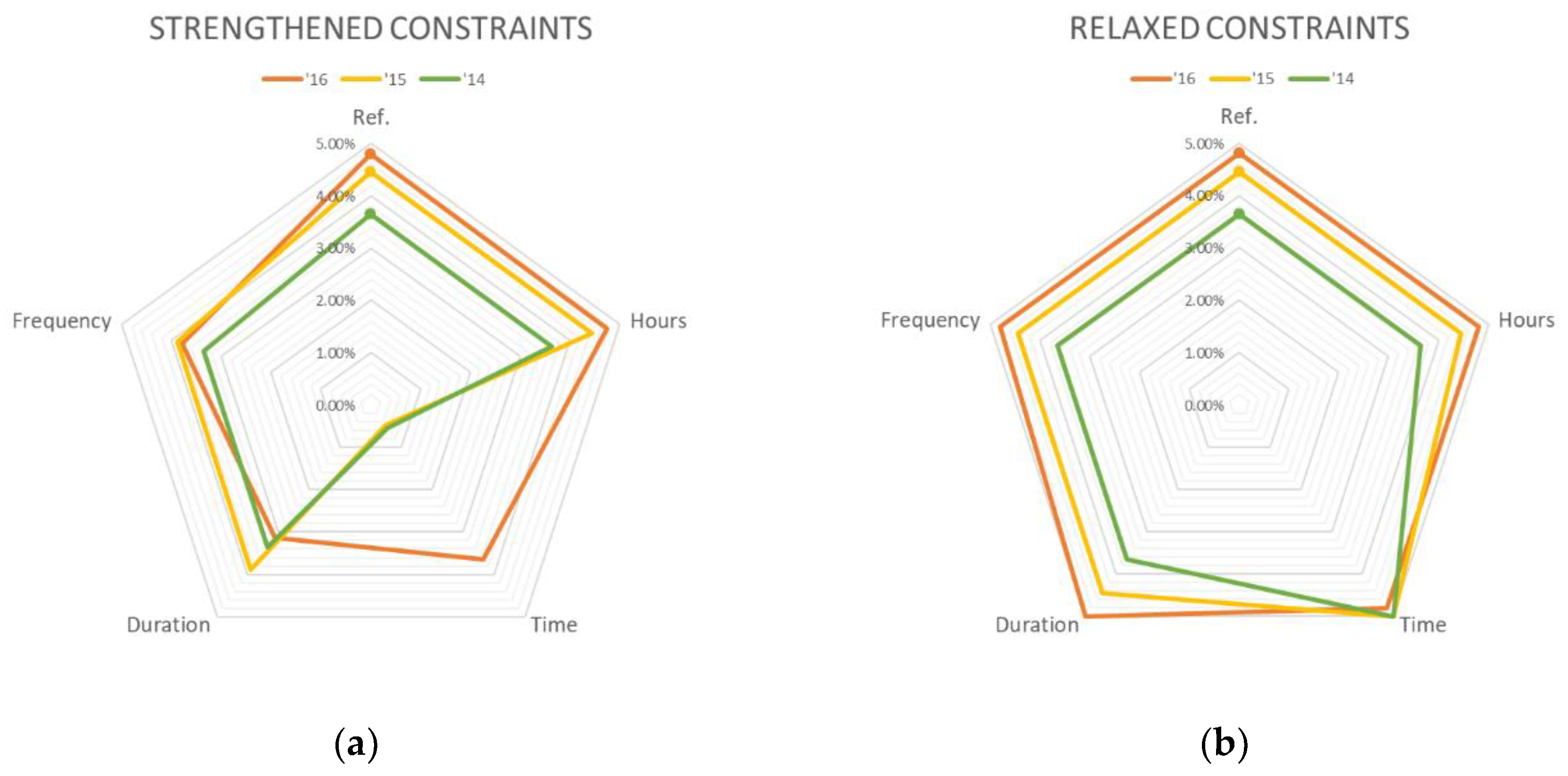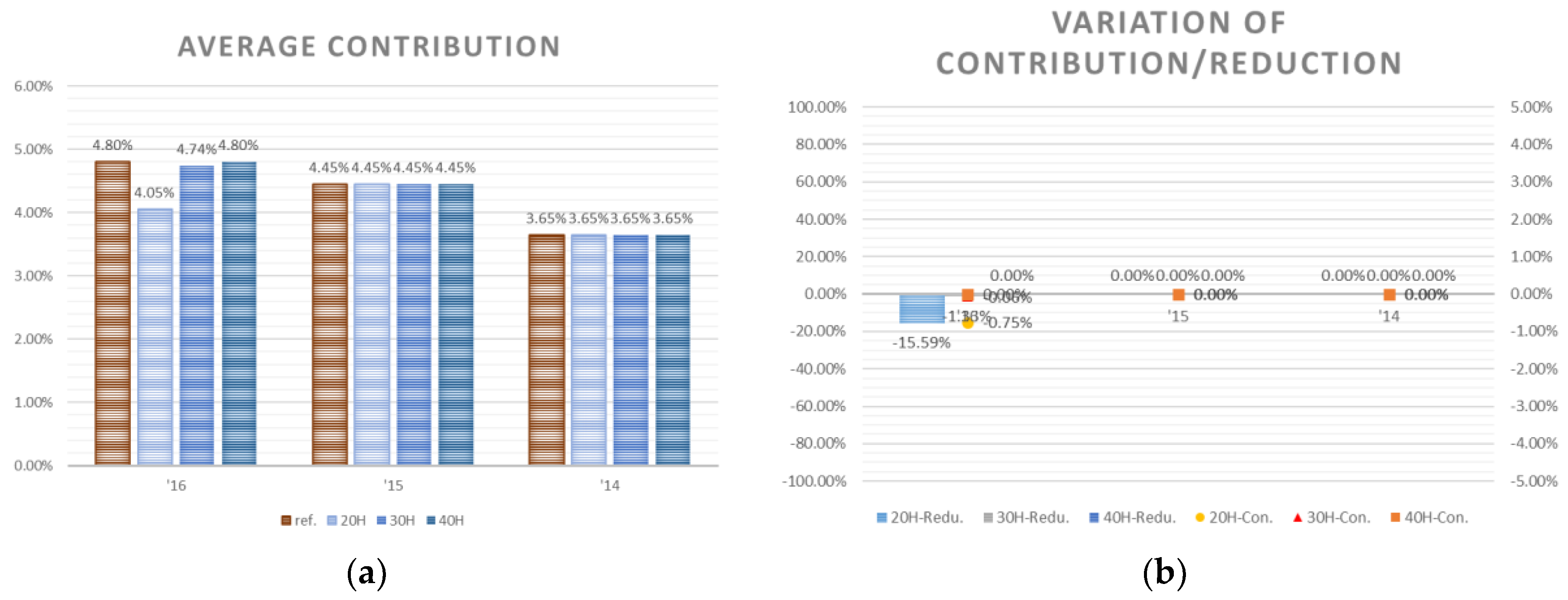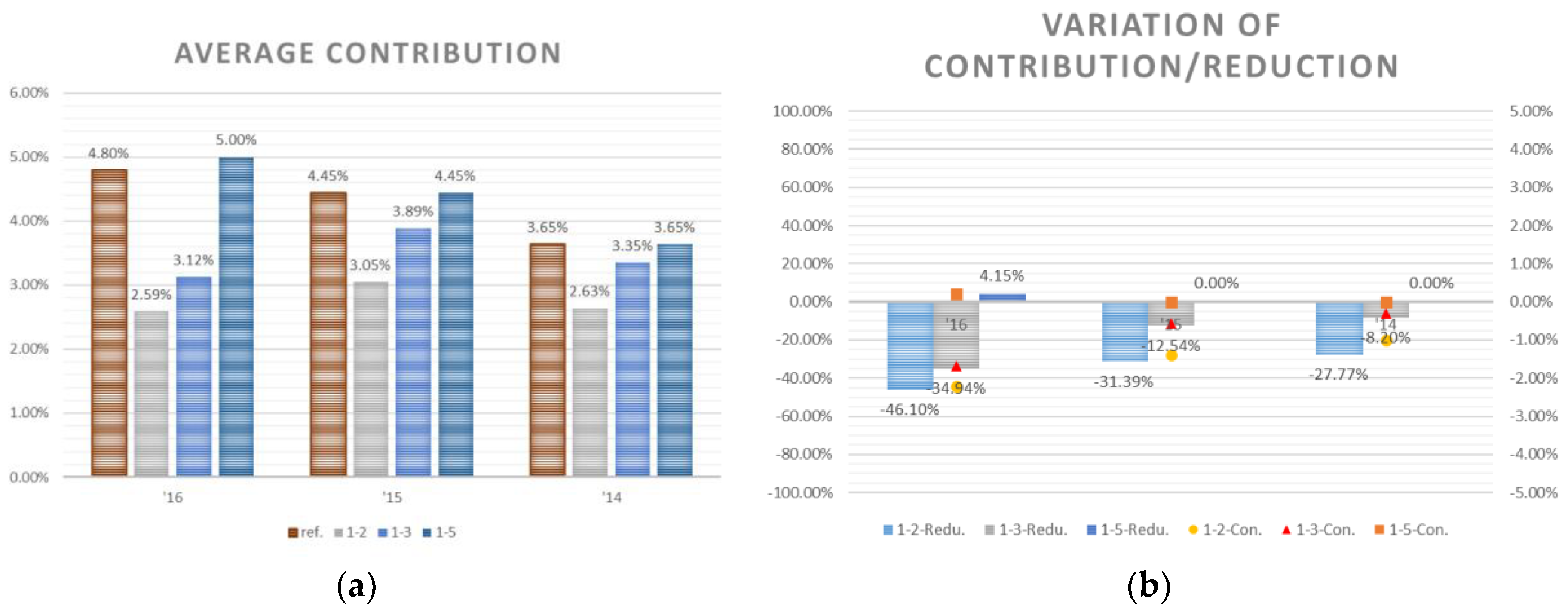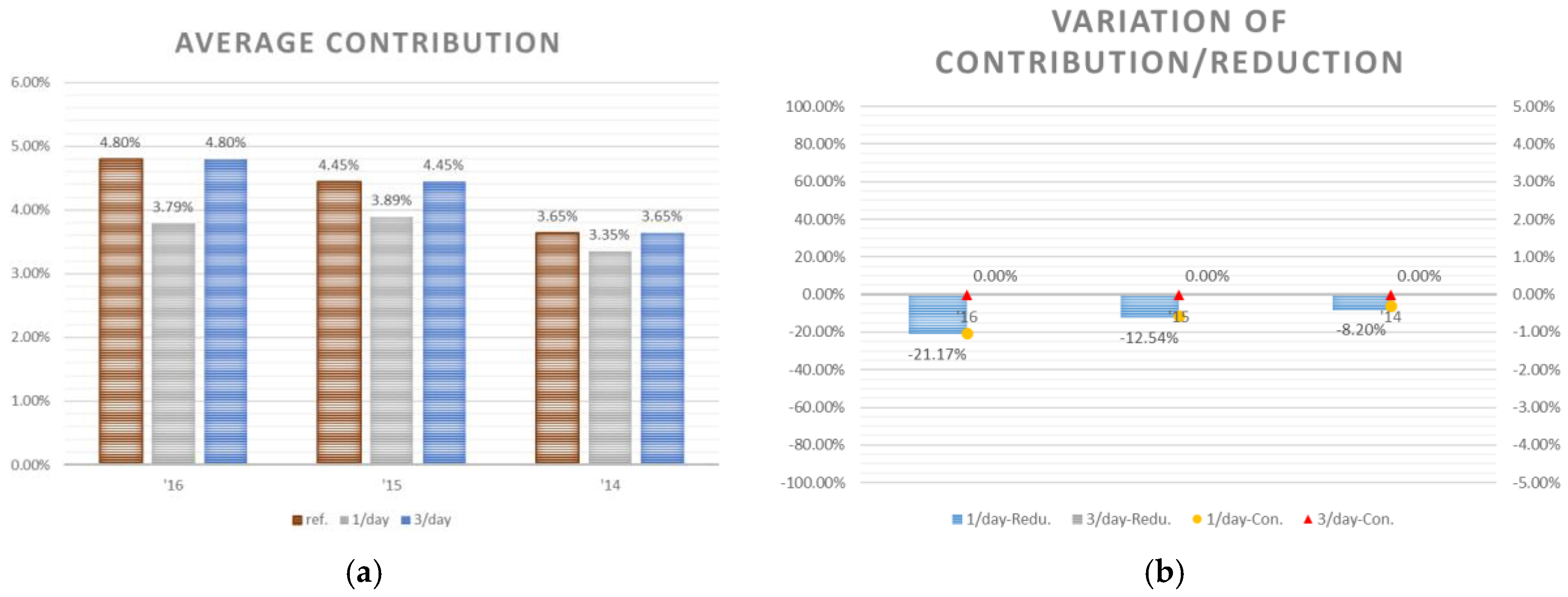In this section, the simulation is conducted to estimate the peak reduction contribution of DR resources and considered DR market operating constraints in order to derive a more accurate reduction effect in the Korean electricity market. In addition, sensitivity analysis is conducted for each constraint to find factors inhibiting the reduction effects of the current DR market system and improvement ways are suggested.
One important factor determining annual peak demand is the electricity demand pattern for that year. Summing up real-time electricity use reveals a demand pattern, which has a certain shape or characteristic, in a specific time period (e.g., day, month, year, and so on). These patterns of electricity demand differ every year, as they are subject to various environmental impacts. The patterns of electric power demand on weekdays and weekends are different, and there is significant difference in electricity use between daytime and nighttime.
Since the annual peak is determined at the time of highest demand in the year, it is necessary to manage DR resources appropriately, according to DR market regulations, to reduce annual peak demand effectively. However, owing to operational restrictions on DR resources in the Korean DR market, it is important to understand the electricity load pattern to maximize the peak reduction effect, while complying with regulations.
Consequently, Korea has exhibited widely varying patterns of electricity demand in 2014–2016, which is substantiated by the peak reduction simulation results. To improve the reliability of the simulation, the patterns are analyzed for the past three years, perform the simulation for each year, and discuss the results below.
3.1. Simulation Overview
The estimated annual peak reduction contribution was obtained in the General Algebraic Modeling System (GAMS) environment and solved by CPLEX, which can solve MILP effectively [
28]. The formulation was applied to simulate the Korean electricity market, and the basic data set for the simulation was from the real power system.
3.1.1. Input Data and Assumptions
The data set used in this paper is from the Korea Electric Power Corporation (KEPCO), and the data produced for the simulation are based on the 8th Basic Plan for Long-term Electricity Supply and Demand (BPE) from Korea Power Exchange (KPX) [
29]. The BPE is published biennially, and the 8th BPE from the end of 2017, addresses the 2017–2031 period.
1. Electricity load
In the simulation, the future electricity demand patterns for 15 years (2017–2031) are forecasted based on the power generator performance data (demand before DR event) for each hour from 2014 to 2016. As prediction is beyond the main research purpose of this study, the future electricity demand assumed in a simple method without using complex formulas or regression analysis. The method of predicting future electricity demand patterns is based on the 8th BPE demand side management plan, and electricity load patterns are forecasted to meet the annual peak demand and power consumption. More specifically, after setting the peak demand of the forecast year to be equal to the annual peak demand of the 8th BPE, the electricity demand adjusted for the remaining time zones according to the year pattern of the three simulations (2014 to 2016). At this time, the electricity demand is proportionally increased, and the sum of all annual electricity demand per year is set equal to the forecasted power consumption of the 8th BPE before demand management. The annual peak demand and power consumption forecasted by the 8th BPE are shown in
Table 1 below.
2. Demand Response Resources
The total registered capacity of DR resources is based on a total of 4352 MW (62 units), including 467 MW of new DR resources registered in May 2017, and the total registered capacity of DR resources for the next 15 years is assumed.
Considering that DR resource registration capacity is increasing and future DR resource recruitment will be extended to small-scale customers such as commercial buildings, DR resource registration capacity for the next 15 years is set to gradually increase, corresponding to 5% of the expected peak demand (MW) for each year.
Table 2 below shows the DR resource registered capacity per year.
3.1.2. Simulation Design
This simulation calculates the annual peak contribution effect based on the 15-year future demand pattern estimated in
Section 3.1.1 and compliance with current market rules. This result is considered a reference case for analyzing the sensitivity of each constraint. Sensitivity analysis for each constraint is conducted by setting four policy constraints that affect the peak reduction effect as variables and adjusting the condition range incrementally. Each result is compared with the reference case and the difference is quantitatively analyzed.
The sensitivity analysis is carried out in two stages. The initial stage measures and compares the results of the simulations by changing the conditions of each variable (by strengthening or mitigating one step). It is implemented as a one-step strengthening adjustment and a one-step relaxing adjustment for each policy variable. Although the adjustment method for each variable is slightly different, basically each level adjustment is determined in integer units.
The “Maximum Dispatch Duration” variable is set at 30 and 70 h to examine a level at which a meaningful change was observed. The “Dispatchable Time” variable is set to shift the entire time zone without changing the total time available. The time zone is 08:00 to 19:00 and 10:00 to 21:00 for each.
Since the condition of each variable is not a parallel relation, it is difficult to compare directly. For example, “Maximum Dispatch Duration” is a constraint that determines the total amount of time that a DR resource may participate in DR events annually. Therefore, the condition must be adjusted in units of time such as 60 and 50 h. On the other hand, since the “Dispatchable Time” constraint is a condition that adjusts the time slot to perform the task, it is necessary to adjust the time zone, such as from 9:00 to 20:00, in which the DR event can occur.
Therefore, in this paper, a more detailed sensitivity analysis was performed considering the characteristics of each constraint. All possible conditions for the policy variable are assigned a range of integer values. Simulation results in which meaningful changes are detected in all cases are selected and included.
The condition cases for each policy variable were classified as follows
Table 3.
For simplicity, abbreviations of the policy constraints in
Table 3 are used.
3.2. Simulation Results
An analysis of power demand patterns for the past three years (2014–2016) shows that each yearly pattern has significantly different characteristics, and simulation results suggest that the determinants affecting the annual peaks are different. In this section, annual peak demand in each year is examined in detail based on the reference case to estimate the annual peak reduction effect and to identify the determining factors.
In 2016, the demand for electricity for 7 h on August 12 was within the highest 60th for the year. In general, it is possible that the DR resource participates in the DR event two times for four hours a day, up to 8 h, but this is virtually impossible because DR resources could not participate at 13:00. Therefore, due to the lack of participation in some time periods on August 12, the annual peak demand will be determined from among the seven hours, which is the 17th time zone demand with the lowest power demand in that day. Demand at that time can be determined as the annual power peak if there is no higher demand than the 17th for a situation that violates constraints.
In 2015, the time slot with the 76th highest annual power demand was 08:00–09:00, which is outside DR dispatchable time. Therefore, if there is no higher demand than this after the DR event in the same year, the DR demand is not determined by the DR event and this could be the annual peak demand since the DR resource was not utilized at that time.
There was high demand for electricity in 2014 between 08:00 and 09:00 (which is outside of DR dispatchable time), mainly due to morning demand. The 29th highest annual electricity demand occurred between 08:00 and 09:00, and demand reduction cannot be requested in this period despite the high demand because the DR event does not work; therefore, it can be determined as the annual peak demand.
Because the peak determining factors are different according to the demand pattern for each year, there are slight differences in the results. The peak reduction contribution reduces demand by 3.65–4.8% of the annual peak demand. The simulation results for the three years are summarized in
Table 4, which is the reference case for the sensitivity analysis.
Based on these simulation results, the initial sensitivity of each constraint is analyzed by simulation, and a different setting range is applied to each constraint condition according to its characteristics. The results are shown in
Table 5 and
Table 6. Sensitivity simulations for relaxed constraints were set by adjusting the condition of each constraint and assuming that the DR resource would more readily participate in DR events. In contrast, the sensitivity simulation results for strengthened constraints were designed to hinder the participation of DR resources in DR events by adjusting the time period or the limiting participation time of each constraint.
The average contribution, shown in
Table 5 and
Table 6 below, refers to the peak reduction effect from DR events on average from 2017 to 2031. It shows how much peak demand is reduced compared to before the DR event. Increased contribution implies an increased peak reduction contribution by alleviating the condition of each constraint, and increased reduction indicates how much the overall peak demand reduction has increased as the contribution increases. On the contrary, decreased contribution and decreased reduction mean a decreased peak reduction contribution and rate of peak reduction when the constraints are strengthened.
In
Table 5 and
Table 6, peak determinants are an indicator of which factors determine the annual peak in the simulation in terms of hours, time, duration, and frequency. Max is the case where the annual peak is reduced by maximizing the utilization of DR resources. On the other hand, Exh. is the case where all resources are exhausted due to a lack of DR resources, but the peak reduction effect is not as great as expected.
As a result of the simulation, if the constraint condition of each policy variable is marginally relaxed, no significant change compared to the existing reference case is observed. Nevertheless, when the conditions of variables such as “Time” and “Duration” are relaxed, power peaks can be maximally reduced by utilizing all the DR resources in some electricity demand patterns.
For example, in 2014, since there was high electricity demand at a time when a DR event could not occur, high demand was determined as an annual peak demand without using DR resources. In such a case, the peak reduction effect can be greatly improved even if only a slight adjustment of the time period in which the DR resource is available is possible. Simulation results show that the overall peak reduction effect has increased by about 1.36 percentage points, from 3.65% to 5%. This number may seem small, but is actually an increase of more than 37% compared to the reference case demand reduction capacity. The capacity is about 1174 MWh or more, which is equivalent to the capacity of one nuclear power plant.
On the contrary, if the constraint condition of the policy variable is strengthened, the peak reduction effect is significantly reduced in most results for all variables. In particular, findings are that the effect is greatly reduced by adjusting the range of conditions for the “Time” variable, and the peak reduction effect appeared to be low in some cases.
For example, in the case of the electricity demand pattern in 2015, because the demand is concentrated in a specific period, even if the period for initiating the DR event is shifted by one hour, the condition becomes very severe and the peak reduction effect is greatly reduced. Simulation results show that the overall peak reduction effect is only 0.48%, down 3.95 percentage points from 4.45%, which is about 89% less than the reference case demand reduction capacity. When converted to capacity, it is equivalent to about 3429 MWh, or the capacity of three nuclear power plants.
Figure 1 graphically shows the average contribution when each constraint is strengthened or relaxed.
After that, adjustment ranges are set for each operational constraint and repeat the simulation by incrementing the level until meaningful results are observed. The detailed sensitivity analysis results for each constraint are presented next.
3.3. Impact Analysis
As mentioned in the previous section, the policy constraints that determine the annual peak demand are defined as four variables, and each policy variable has a different extent of influence on the annual peak demand decisions. Therefore, in this section, adjustment ranges are set according to the characteristics of each policy variable and simulate for every case where a significant change is observed. In addition, simulation results are analyzed, critical variables that exert the greatest influence on peak reduction are identified, and ways to increase this effect are sought.
3.3.1. Maximum Dispatch Duration (Hours)
Under current regulations, the time allotted to each DR resource for taking part in DR events is limited to 60 h per year. To quantify the change in the annual peak reduction effect caused by adjusting the policy variables, simulate is conducted for the effects of different limits by changing the limit from 20 to 90 h in units of 10 h.
Simulation results show that reducing or increasing the maximum time for participating in DR events does not affect peak reduction; other variables are more significant determinants. However, reducing the annual duration time more severely lessens the peak reduction effect. At this time, all available DR resources are used in peak reduction, but the peak reduction effect is only slightly reduced compared to the reference case. The simulation results of the sensitivity analysis varying the maximum dispatch duration are summarized in
Table 7. Also, the result of the average contribution and the variation of contribution and reduction are graphically shown in
Figure 2.
3.3.2. Dispatchable Time (Time)
In the initial sensitivity analysis, only the available time period for participation is altered, without changing the total time available for DR events. In this sensitivity analysis, both the changeable time slot and the entire available time range are widened and narrowed.
According to the simulation results, the rate of change is larger than the other three policy variables in most cases. As expected, when the time period of the DR event is changed to include more time periods and the time period is moved to around the reference case time, the peak reduction effect is increased. In some cases, the annual peak demand could be reduced by a maximum amount.
However, when the width of the DR event time zone is reduced and the time slot is also partially excluded, the peak reduction effect is significantly reduced through almost the entire demand pattern. Even if the width is extremely small, there may be no peak reduction effect at all. The simulation results for the sensitivity analysis varying dispatchable time are summarized in
Table 8.
Figure 3 graphically shows the result of the average contribution and the variation of contribution and reduction.
3.3.3. Sustained Response Period (Duration)
Once the DR event starts, the maximum duration to sustain demand reduction is set to 2, 3, 5, and 6 h (recall the reference case of 4 h). According to the results of the simulation, increasing the duration of demand reduction does not greatly improve the peak reduction effect. However, reducing the participation time of the duration constraint significantly reduced the peak reduction effect in all cases, and the factors determining the annual peak demand in all cases was the duration and the frequency constraint.
For example, in the case of the electricity demand pattern in 2016, if the duration of demand reduction for each DR resource is a maximum of 2 h, overall peak reduction effect has decreased by about 2.21 percentage points from 4.80% to 2.59%. This is a decrease of more than 46% from the reference case demand reduction capacity. The equivalent capacity is about 1916 MWh or more, or two nuclear power plants. The simulation results for the sensitivity analysis varying the sustained response period are summarized in
Table 9. Also, the result of the average contribution and the variation of contribution and reduction are graphically shown in
Figure 4.
3.3.4. Available Number of Dispatches (Frequency)
Currently, each DR resource can participate in an event up to twice a day. The sensitivity simulation is conducted for each of two possible cases.
Simulation results show that increasing the number of events that a DR resource can participate in during a day has little effect on the peak reduction effect. On the other hand, limiting the possibility of event participation to once a day significantly reduces the peak reduction effect compared to the reference case. The results for sensitivity analysis varying the number of dispatches per day are summarized in
Table 10.
Figure 5 below graphically shows the result of the average contribution and the variation of contribution and reduction.









